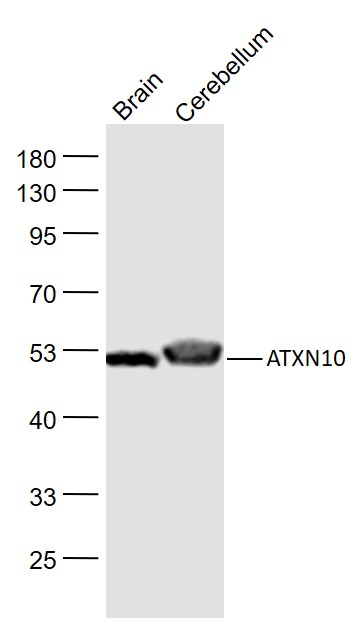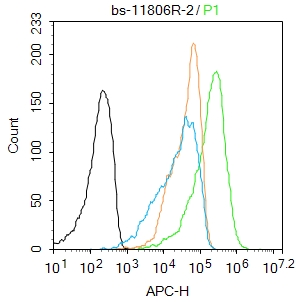
Rabbit Anti-ATXN10 antibody
Ataxin 10; Ataxin-10; ATX10_HUMAN; Atxn10; Brain protein E46 homolog; E46L; FLJ37990; HUMEEP; Like mouse brain protein E46; SCA10; Spinocerebellar ataxia 10; Spinocerebellar ataxia type 10 protein.
View History [Clear]
Details
Product Name ATXN10 Chinese Name 脊髓小脑共济失调10抗体 Alias Ataxin 10; Ataxin-10; ATX10_HUMAN; Atxn10; Brain protein E46 homolog; E46L; FLJ37990; HUMEEP; Like mouse brain protein E46; SCA10; Spinocerebellar ataxia 10; Spinocerebellar ataxia type 10 protein. Research Area Cell biology Neurobiology Immunogen Species Rabbit Clonality Polyclonal React Species Mouse, (predicted: Human, Rat, Dog, Pig, Cow, Horse, Sheep, ) Applications WB=1:500-2000 ELISA=1:5000-10000 IHC-P=1:100-500 IHC-F=1:100-500 Flow-Cyt=2ug/Test ICC=1:100-500 IF=1:100-500 (Paraffin sections need antigen repair)
not yet tested in other applications.
optimal dilutions/concentrations should be determined by the end user.Theoretical molecular weight 53kDa Cellular localization cytoplasmic Form Liquid Concentration 1mg/ml immunogen KLH conjugated synthetic peptide derived from human ATXN10/SCA10: 21-120/475 Lsotype IgG Purification affinity purified by Protein A Buffer Solution 0.01M TBS(pH7.4) with 1% BSA, 0.03% Proclin300 and 50% Glycerol. Storage Shipped at 4℃. Store at -20 °C for one year. Avoid repeated freeze/thaw cycles. Attention This product as supplied is intended for research use only, not for use in human, therapeutic or diagnostic applications. PubMed PubMed Product Detail Spinocerebellar ataxia (SCA) is an autosomal dominant neurodegenerative disorder characterized by ataxia and selective neuronal cell loss. SCA is caused by the expansion of a translated CAG repeat, encoding a polyglutamine tract in SCA gene products, known as ataxins. The ataxin proteins are ubiquitously expressed in nervous tissue, but are primarily detected in cerebellum, brain stem and spinal cord in the central nervous system. Ataxin-10 is a cytoplasmic protein that belongs to the family of armadillo repeat proteins. A loss of ataxin-10 in primary neuronal cells causes increased apoptosis of cerebellar neurons. Ataxin-10 interacts with p110, an O-Linked beta-N-acetylglucosamine transferase, and may be important in the regulation of intracellular glycosylation levels and homeostasis in the brain. Spinocerebellar ataxia type 10 (SCA10) is an autosomal dominant disorder that causes cerebellar ataxia and seizures. SCA10 is caused by an expansion of an ATTCT pentanucleotide repeat in intron 9 of the ataxin-10 gene.
Function:
Necessary for the survival of cerebellar neurons. Induces neuritogenesis by activating the Ras-MAP kinase pathway. May play a role in the maintenance of a critical intracellular glycosylation level and homeostasis.
Subunit:
Homooligomer. Interacts with OGT. Interacts with GNB2. Interacts with IQCB1.
Subcellular Location:
Cytoplasm, perinuclear region.
Tissue Specificity:
Expressed in the central nervous system.
DISEASE:
Defects in ATXN10 are the cause of spinocerebellar ataxia type 10 (SCA10) [MIM:603516]. Spinocerebellar ataxia is a clinically and genetically heterogeneous group of cerebellar disorders. Patients show progressive incoordination of gait and often poor coordination of hands, speech and eye movements, due to degeneration of the cerebellum with variable involvement of the brainstem and spinal cord. SCA10 is an autosomal dominant cerebellar ataxia (ADCA).
Similarity:
Belongs to the ataxin-10 family.
SWISS:
Q9UBB4
Gene ID:
25814
Database links:Entrez Gene: 25814 Human
Entrez Gene: 54138 Mouse
Omim: 611150 Human
SwissProt: Q9UBB4 Human
SwissProt: P28658 Mouse
SwissProt: Q5RE06 Orangutan
Unigene: 475125 Human
Unigene: 248906 Mouse
Product Picture
Brain (Rat) Lysate at 40 ug
Cerebrum (Mouse) Lysate at 40 ug
Primary: Anti-ATXN10 (SL11806R) at 1/1000 dilution
Secondary: IRDye800CW Goat Anti-Rabbit IgG at 1/20000 dilution
Predicted band size: 53 kD
Observed band size: 52 kD
Blank control: Mouse spleen.
Primary Antibody (green line): Rabbit Anti-ATXN10 antibody (SL11806R)
Dilution: 1μg /10^6 cells;
Isotype Control Antibody (orange line): Rabbit IgG .
Secondary Antibody : Goat anti-rabbit IgG-AF647
Dilution: 1μg /test.
Protocol
The cells were fixed with 4% PFA (10min at room temperature)and then permeabilized with PBST for 20 min at room temperature. The cells were then incubated in 5%BSA to block non-specific protein-protein interactions for 30 min at at room temperature .Cells stained with Primary Antibody for 30 min at room temperature. The secondary antibody used for 40 min at room temperature. Acquisition of 20,000 events was performed.
Bought notes(bought amounts latest0)
No one bought this product
User Comment(Total0User Comment Num)
- No comment




 +86 571 56623320
+86 571 56623320
 +86 18668110335
+86 18668110335

